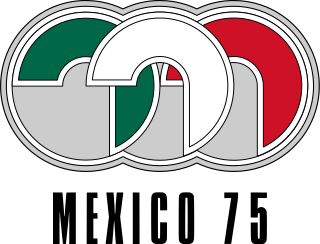
The 1971 Pan American Games, officially known as the VI Pan American Games and commonly known as Cali 1971, were held in Cali, Colombia, from 30 July to 13 August 1971. A total of 2,935 athletes from 32 countries participated in 17 sports.

The 1975 Pan American Games, officially known as the VII Pan American Games and commonly known as Mexico 1975, were held in Mexico City, Mexico, from October 12 to October 26, 1975, exactly twenty years after the second Pan American Games were held there. It was the third major sporting event held in the Mexican capital in seven years, after the 1968 Summer Olympics and the 1970 FIFA World Cup.

The 1983 Pan American Games, officially known as the IX Pan American Games and commonly known as Caracas 1983, were held in Caracas, Venezuela from August 14 to August 29, 1983. The games were the first major international competition to include relatively accurate steroid testing.

The 1991 Pan American Games, officially known as the XI Pan American Games and commonly known as Havana 1991, were held in Havana, Cuba from 2 to 18 August 1991. There were 4,519 athletes from 39 countries of the PASO community, with events in 33 different sports. The main stadium was the Estadio Panamericano, a multi-use stadium in Havana that holds 50,000 people.
Boxing competitions at the 1979 Pan American Games in San Juan were held from July 2 to 14 at the Trujillo Alto Coliseum and the Roberto Clemente Coliseum.

Peru at the Pan American Games. The Peruvians had participated in all editions of the games, except in 1955 in Mexico City. They have won a total of 19 gold medals, 40 silver and 90 bronze and 149 overall counting the 2019 Panamerican Games in Lima.

Puerto Rico first participated at the Pan American Games in 1951 and has competed in every edition since then. Puerto Rico did not compete at the 1990 Winter Pan American Games in Las Leñas. Puerto Rico won the first medal at the 1955 Pan American Games in Mexico City with two silver medals and two bronze medals. 12 years later in Winnipeg, Puerto Rico won the first gold medal at the Pan American Games.

The Dominican Republic at the Pan American Games.

The 2019 Pan American Games, officially the XVIII Pan American Games and commonly known as Lima 2019, were a multi-sport event governed by the Panam Sports Organization held in Lima, Peru from July 26 to August 11, 2019, with preliminary rounds in certain events having begun on July 24, 2019. These were the first Pan American Games to be held in Peru, and the seventh to be held in South America.

Ecuador at the Pan American Games.

Bolivia has competed at every edition of the Pan American Games since the fifth edition of the multi-sport event in 1967. The first Bolivian medal was a silver in the 1991 taekwondo tournament. Since then the country has won one gold medal, three silver medals, and eight bronze medals between 2003 and 2019. Aside from two silver medals in taekwondo and tennis, and a bronze in cycling, all the other medals came from racquetball. As of the last Pan American Games in 2023, Bolivia is twenty-third on the all time medals list. Bolivia competed in the first ever Pan American Winter Games in 1990, however it failed to medal.

Costa Rica at the Pan American Games.

Haiti has competed at the Pan American Games since its inaugural edition in 1951.

Trinidad and Tobago has competed from the first edition of the Pan American Games.

Honduras at the Pan American Games.

Paraguay has sent athletes to all editions of the games, except in two editions: 1959 and 1963. Paraguayan athletes have won 2 gold medals, 5 silver and 15 bronze and 22 overall counting the 2023 Panamerican Games in Santiago.

Uruguay at the Pan American Games.
The men's football tournament at the 2019 Pan American Games will be held in Lima from 29 July to 10 August 2019. The eight teams involved in the tournament were required to register a squad of 18 players, including two goalkeepers.
The men's high jump competition of the athletics events at the 1979 Pan American Games took place on 11 July at the Estadio Sixto Escobar. The defending Pan American Games champion was Tom Woods of the United States.
The men's long jump competition of the athletics events at the 1979 Pan American Games took place on 7 July at the Estadio Sixto Escobar. The defending Pan American Games champion was João Carlos de Oliveira of Brazil.
















